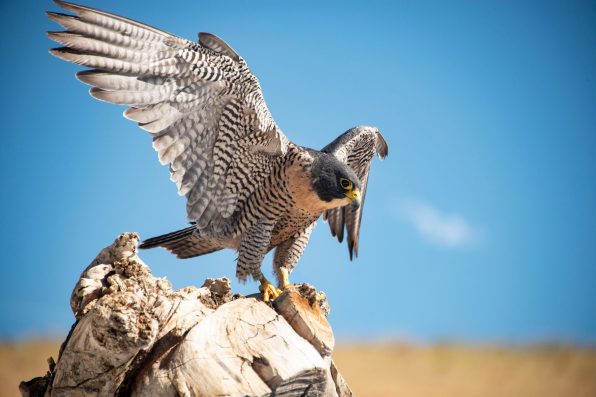Peregrine Falcons Rule The Skies As The Fastest Animal In The Air, Reaching Speeds Equivalent To The Average NASCAR Racer

If you ask anyone what the fastest animal on earth is, they’ll likely name the cheetah. While it’s true that the cheetah can outrun any land animal, it is no match for the feathered, winged creatures that dominate the skies.
Birds are the only members of the animal kingdom that can surpass a cheetah in speed. In fact, the peregrine falcon has got the large cat beat by a long shot. When it comes down to the fastest animal in the air, the peregrine falcon definitely deserves the title.
The peregrine typically cruises along at an average speed of 30 mph. It can hit nearly 70 mph when pursuing prey in level flight. But the bird’s most impressive feat is when it executes its hunting dives.
During their dives, peregrine falcons will soar high into the air. Then, they will plunge straight down, reaching speeds over 200 mph. That may not be as fast-moving as a bullet, but it is a match for the average NASCAR racer’s top speed.
This amazing bird of prey can be found on every continent except Antarctica. In North America, they inhabit areas from the Rocky Mountains all the way down to Mexico.
They also live along the west and east coasts. During the winter, they migrate south, spending the cooler months in Mexico, the Gulf Coast, and the Caribbean.
These falcons feast primarily on other birds, which they snatch right out of the sky. They eat a wide variety of birds, such as pigeons, ducks, and songbirds.
They’re even known for attacking avians as large as geese, loons, and cranes. Additionally, they will snack on a few small mammals, like bats, but will rarely feed on insects or carrion.
Peregrine falcons have interesting nesting habits. They dwell on cliff ledges that can be anywhere from 25 to 1,300 feet off the ground. Over the years, the range of their habitat has declined, forcing them to find suitable nesting locations in the cities. Window ledges on tall buildings, bridges, and other structures are all fair game for nesting grounds.

gevans – stock.adobe.com – illustrative purposes only, not the actual bird
Generally, peregrine falcons mate for life and return to the same nesting area every year. The male will hunt for food while the female stays with the young. The female usually lays three to four eggs at a time.
The eggs are pale and creamy to reddish-brown in color, heavily marked with warm, brown spots. After the chicks hatch and grow a little bigger, the female will also go out to hunt. Chicks will take their first flight in about 40 days.
Peregrine falcon numbers are relatively stable today, but that wasn’t always the case. In the 1950s to ’70s, the peregrine was driven to the brink of extinction due to pollutants like DDT, which caused their eggshells to thin. Luckily, their population quickly rebounded after DDT was banned.
Sign up for Chip Chick’s newsletter and get stories like this delivered to your inbox.
More About:Animals





